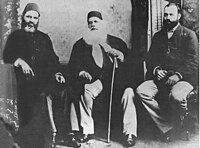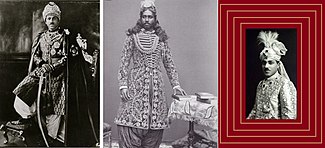This is an old revision of this page, as edited by Σουνιτική άμυνα (talk | contribs) at 18:38, 11 October 2024 (Adding Ahmed 1997 in 'Bibliography'). The present address (URL) is a permanent link to this revision, which may differ significantly from the current revision.
Revision as of 18:38, 11 October 2024 by Σουνιτική άμυνα (talk | contribs) (Adding Ahmed 1997 in 'Bibliography')(diff) ← Previous revision | Latest revision (diff) | Newer revision → (diff) Attire of the Muslim aristocracy of South Asia

Shirwani is a long-sleeved outer coat worn by men in South Asia. Like the Western frock coat, it is fitted, with some waist suppression; it falls to below the knees and is buttoned down the front.
It is usually collarless, have a shirt-style collar, or a stand-up collar in the style of the Mandarin collar. It evolved in the Indian subcontinent in the 19th-century as a result of the outer garment of the late Mughal period, the angarkha—itself evolved from the Persian cape, balaba—being given a western style with a button-down front.
Etymology
The name of the attire is plausibly derived from Shirvan or Shirwan, a region of present-day Azerbaijan, due to the folk dress of that area (Chokha) which resembles the shirwani. Therefore, the garment may also be a Mughalized derivative of the Caucasian dress due to the ethnocultural linkages of Turco-Persian affinity during the Middle Ages.
History

The shirwani originated in the early 19th century in South Asia, before being more generally adopted in the late 18th century. It was originally associated with Muslim aristocracy during the period of British rule. According to Emma Tarlo, the shirwani evolved from a Persian cape (balaba or chapkan), which was gradually given a more Indian form (angarkha), and finally developed into the shirwani, with buttons down the front, following European fashion. It originated in 19th century British India as the European style court dress of regional Mughal nobles of northern India. It appeared first at Lucknow in the 1820s.
Description

The shirwani evolved from a Persian cape (balaba or chapkan) and was developed into the shirwani, with buttons down the front, following European fashion.
Use
The shirwani is now famous as a wedding outfit, and it has always been popular as an outfit which can be worn on formal occasions. The shirwani signified the dignity and etiquette of the nobility, and it used to be the court dress of the nobles of Turkish and Persian origin. It is the national dress of Pakistan for men. A shirwani carries a regal feel.
India
Main article: AchkanIn India, the achkan has been generally worn, which is much shorter than the shirwani. The achkan was worn on formal occasions in winter, especially by those from Rajasthan, Punjab, Delhi, Jammu, Uttar Pradesh and Hyderabad. The achkan is generally associated with the Hindus while the shirwani was historically and is still favored by Muslims. The two garments have significant similarities, though shirwanis typically are more flared at the hips and achkans are lengthier than simple shirwanis. The achkan later evolved into the Nehru Jacket, which is now popular in India. In India, the achkan or shirwani is generally worn in combination with the churidar as the lower garment.
-
 Jawaharlal Nehru (left) wearing an achkan with churidar.
Jawaharlal Nehru (left) wearing an achkan with churidar.
-
Achkan shirwani and churidar (lower body) worn by Arvind Singh Mewar and his kin during a Hindu wedding in Rajasthan, India.
Bangladesh

In Bangladesh, the shirwani is worn by people on formal occasions such as weddings and Eid.
Pakistan

After the independence of Pakistan, Muhammad Ali Jinnah frequently wore the shirwani. Following him, most people and government officials in Pakistan such as the President and Prime Minister started to wear the formal black shirwani over the shalwar kameez on state occasions and national holidays. General Muhammad Zia-ul-Haq reportedly made it compulsory for all officers to wear shirwani on state occasions and national holidays.
-
 Muhammad Ali Jinnah, founder of Pakistan, is sitting on the Chair of Governor General, sometimes referred as Pakistan's Throne, wearing shirwani.
Muhammad Ali Jinnah, founder of Pakistan, is sitting on the Chair of Governor General, sometimes referred as Pakistan's Throne, wearing shirwani.
Modern shirwanis
Shirwani are mostly worn in Pakistan, India and Bangladesh. These garments usually feature detailed embroidery or patterns. One major difference between shirwani-wearing habits is the choice of lower garment: while in India it is mainly worn with churidars or pyjamas, in Pakistan and Bangladesh it is mainly worn with a shalwar.
Pakistani journalist, filmmaker and activist, Sharmeen Obaid-Chinoy appeared in shirwani when she won the Academy Award for Best Documentary Short Film in 2012 and 2015.
References
- Tarlo 1996, p. xii.
- Tarlo 1996, p. 47.
- "Sherwani | Meaning of Sherwani by Lexico". 22 December 2019. Archived from the original on 22 December 2019. Retrieved 30 October 2022.
- ^ Jhala, Angma Dey (6 October 2015). Royal Patronage, Power and Aesthetics in Princely India. Routledge. ISBN 978-1-317-31657-2.
- ^ Tarlo 1996.
- ^ The Social Life of Things: Commodities in Cultural Perspective. Cambridge University Press. 29 January 1988. ISBN 978-1-107-39297-7.
- "The Traditional Dress: Sherwani". RiciMelion. Retrieved 27 July 2021.
- "What is a Sherwani?". www.bhangrakids.com. Retrieved 27 July 2021.
- "Shifting Sands: Costume in Rajasthan".
- Langkjær, Michael Alexander (2014). "From Cool to Un-cool to Re-cool: Nehru and Mao tunics in the sixties and post-sixties West". Global Textile Encounters, ed. Marie-Louise Nosch, Zhao Feng, and Lotika Varadarajan. Ancient Textiles Series, Vol. 20, Pp. 227-236: 227 – via www.academia.edu.
- "Nehru's style statement".
- Altogether book. Vikas Publishing House. ISBN 978-93-259-7971-0.
- "Nehru's style statement".
- Ahmed 1997, pp. 99–.
- "The Traditional Dress: Sherwani". RiciMelion. Retrieved 8 August 2021.
- Marcus, Lauren (1 December 2013). "Sources: Encyclopedia of National Dress: Traditional Clothing Around the World". Reference & User Services Quarterly. 53 (2): 197–198. doi:10.5860/rusq.53n2.197c. ISSN 1094-9054.
- "Pakistan's Oscar triumph for acid attack film Saving Face". BBC News. Nosheen Abbas. Retrieved 28 December 2014.
- "Oscar-winning Pakistani Filmmaker Inspired by Canada".
- Clark, Alex (14 February 2016). "The case of Saba Qaiser and the film-maker determined to put an end to 'honour' killings". The Guardian. ISSN 0261-3077. Retrieved 18 February 2016.
- "Sharmeen Obaid-Chinoy is Pakistan's First Oscar Nominee". 24 January 2012. Retrieved 24 January 2011.
- "Sharmeen Obaid-Chinoy fights to end honour killings with her film A Girl in the River". www.cbc.ca. Retrieved 18 February 2016.
Bibliography
- Tarlo, Emma (1996), Clothing Matters: Dress and Identity in India, University of Chicago Press, ISBN 9780226789767,
The historian Abdul Halim Sharar ... shows how the Persian cape (balaba, chapkan) was gradually given a more Indian form (angarkha), and finally developed into the sherwani which had buttons down the front, following European fashion. In the early stages wealthy men's robes were made from the luxury fabrics of muslin and silk and often embroidered. But as they became more Europeanised, they became increasingly like the Englishman's frock coat, made from heavy dull material with less ornamentation and given tight sleeves. Some men added a white shirt collar to the sherwani to complete the look.
- Ahmed, Akbar S. (1997). Jinnah, Pakistan and Islamic Identity: The Search for Saladin. Psychology Press. pp. 99–. ISBN 978-0-415-14966-2.
| Pakistani clothing | |
|---|---|
| Clothes | |
| Headgear | |
| Shawls | |
| Stitching and design |
|
| Footwear | |
| By ethnicity | |
| Clothing in South Asia | |
|---|---|
| History | |
| Clothes |
|
| Headgear | |
| Stitching and design | |
| Footwear | |
| Folk costumes | |||||||||||||
|---|---|---|---|---|---|---|---|---|---|---|---|---|---|
| Africa | |||||||||||||
| Asia |
| ||||||||||||
| Europe |
| ||||||||||||
| South America | |||||||||||||
| North America | |||||||||||||
| Oceania | |||||||||||||